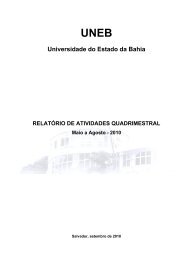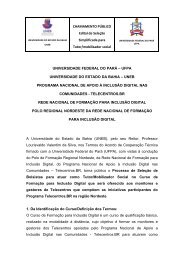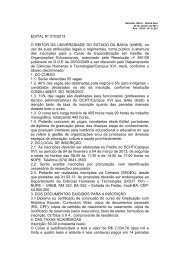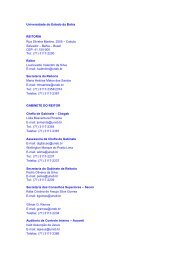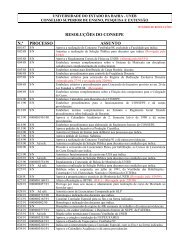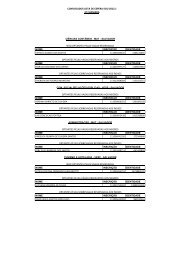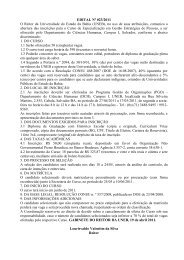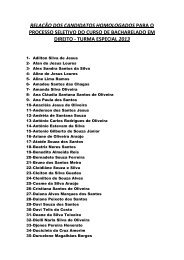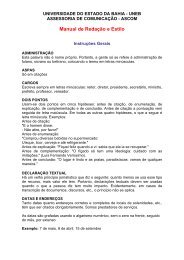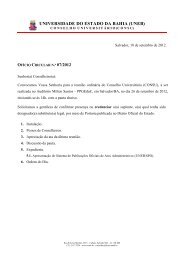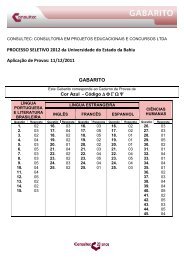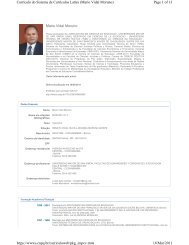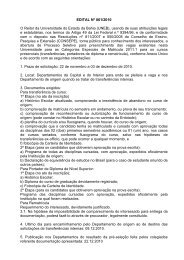Revista da FAEEBA Educação e Contemporaneidade - Uneb
Revista da FAEEBA Educação e Contemporaneidade - Uneb
Revista da FAEEBA Educação e Contemporaneidade - Uneb
Create successful ePaper yourself
Turn your PDF publications into a flip-book with our unique Google optimized e-Paper software.
In search of América: latina/os (re)constructing the U.S.A.<br />
250<br />
worry about speaking English to fit in. (…) The<br />
“English Only” movement is only gonna <strong>da</strong>mage<br />
the greater culture (…) because we’re such a<br />
mixture of many, many cultures. (Latina/o college<br />
student, public forum)<br />
We should learn from other ethnic minorities who<br />
regret that they can’t speak their native language.<br />
(…) We don’t want our children to have that<br />
same regret. (Latina/o community agency leader,<br />
newspaper interview)<br />
It was racism and exclusion, they argued,<br />
that <strong>da</strong>maged the self-esteem and chances for<br />
Latina/os’ upward mobility:<br />
The self-esteem of Hispanic students is suffering<br />
in our schools, because we hear every <strong>da</strong>y of<br />
negative messages about who we are and why<br />
we are here (…). We want to achieve (…) to<br />
organize as a group (…) [to] deal with the<br />
prejudice (…) constructively. (Latina/o high<br />
school student, public forum)<br />
Without that information [ethnic contributions<br />
to the United States], children are handicapped<br />
– they are defenseless – and information about<br />
their heritage is needed to arm them (…). If they<br />
hear nothing (…) then they think, ‘I must be<br />
nothing.’ (Latina/o community leader, newspaper<br />
interview)<br />
The debates in this particular community had<br />
their own local “accent,” but they were held<br />
against the backdrop of a larger national debate<br />
about language, the telling of history, and how<br />
to explain the prevailing sense of decline in the<br />
nation’s wellbeing. The impact of de-industrialization<br />
and the move toward a service economy<br />
were being more intensely felt as economic restructuring<br />
threatened the traditional livelihood<br />
of blue collar male workers. Minorities simultaneously<br />
were entering the middle class and previously<br />
“white” institutions in greater numbers<br />
because of the successes of the civil rights<br />
movements and demanding changes. Conservative<br />
whites, threatened by earlier gains like<br />
government-supported affirmative action programs<br />
and bilingual education, organized to oppose<br />
what they viewed as “reverse racism,”<br />
“government handouts,” and divisive language<br />
and education policies they perceived as pandering<br />
to minorities. English Only and Official<br />
English movements gained ground 21 . Conservative<br />
intellectuals like historian Arthur Schlesinger<br />
joined the raucous debate in publishing<br />
The Disuniting of America (1991), which argued<br />
that the promotion of multiculturalism was<br />
<strong>da</strong>ngerous to democracy because it threatened<br />
the unity of the nation. Racial tensions were<br />
palpable, albeit in a new form.<br />
Into the 21 st Century<br />
While the economic boom beginning in<br />
the mid-1990s helped to momentarily quell some<br />
of the more strident voices, the subsequent economic<br />
downturn and the psychological and economic<br />
impact of the September 11, 2001 attacks<br />
on the World Trade Center Towers have contributed<br />
to a climate of uncertainty and greater<br />
potential for conservative movements. Latinos,<br />
whose demographic growth is being highly publicized,<br />
make an easy target.<br />
Latina/os surpassed African-Americans as<br />
the second largest “racial” group in New York<br />
City in 1996; California joined New Mexico in<br />
becoming a “majority-minority society” in 2000;<br />
and in seven of the ten largest cities Latina/os<br />
now outnumber African Americans (DAVIS,<br />
2001). Calls to close the borders against the<br />
“brown tide rising” have become louder.<br />
California governor Pete Wilson in his reelection<br />
campaign, for instance, spoke of “hordes<br />
of Mexican immigrants,” “invaders” that<br />
“pour” into the U.S., and of California as a state<br />
“awash under a brown tide” (SANTA ANA,<br />
2002, p.286-287). Books like Alien Nation<br />
(BRIMELOW, 1995), which argues that the<br />
American people are in <strong>da</strong>nger of being engulfed<br />
by foreigners, hit a responsive chord among<br />
many Americans. With a sense of social and<br />
economic vulnerability on the rise since the late<br />
1990s, nativist forces have found new villains.<br />
African American “welfare queens,” purported<br />
to be living off the fat of the land, have been<br />
21 See Bigler, 1999 for an analysis of this period, and an upclose<br />
ethnographic study of a community locked in conflict<br />
over multiculturalism and bilingual education.<br />
<strong>Revista</strong> <strong>da</strong> <strong>FAEEBA</strong> – <strong>Educação</strong> e Contemporanei<strong>da</strong>de, Salvador, v. 15, n. 25, p. 239-257, jan./jun., 2006



